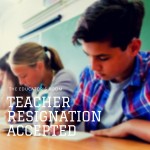I don’t remember the moment it dawned on me that I had unrealistic behavioral expectations.
Maybe it was the second week of school when I realized the honeymoon phase was over. It might’ve been the moment my administration looked at my students in their “lines” and said, “You should be on Level 0 at all times in the hallways! Straight lines! Hands at your sides!”
During one of those #teacherfail moments or the other 2,384,593 times I’ve used the famous teacher phrase “I’ll Wait,” I had a revelation.
[bctt tweet=”Am I setting unrealistic behavioral expectations for my students?” username=””]
I’m not talking about the moments when I’m teaching and students are blatantly talking while I’m talking. I’m not saying we should allow students to parade up and down the hallways like newly released pound dogs. As they get older, they have to understand there is a time to talk and a time to be silent and listen. I get that.
But why must they be dead silent as they take long journeys to another classroom? Why must they walk with their hands by their sides at all times? Why is it not okay to allow small, side conversations while you write something on the board or prepare materials, or even when walking back from the playground? Those are some examples of unrealistic behavioral expectations.
I believe at a certain point, we have to realize we can’t expect our students to be dead silent during 90% of their school day.
I’ve caught myself yelling and taking Dojo points for students talking while I’m NOT talking. I’ve tried to retrain my students on how to walk up and down the hallways without a peep, single file, like inmates.
The reality of what I was consistently asking my students to do was truly unattainable. If we’re being honest as teachers, we can’t even sit through a 15 minutes staff meeting (because those are 15 minutes…not) without having a side conversation, pulling out our phones, planning tomorrow’s lessons, or simply not paying attention…. and we’re 21+!
Once I realized the Dojo points meant nothing and practicing during recess had no impact, I had to re-evaluate what I was doing as a teacher and how I was processing what I believed students should be required to do every day in my class and outside of it.
Can we be honest?
What harm is there really in allowing students to talk while you write something on the board? In those moments when you’re trying to find a resource or some supplies, what’s wrong with them having a short conversation as you get it together? If students jump over a line, skip a few steps, or do a quick spin while walking down the hallway, who is that endangering?
Set the expectations.
What I started doing is setting an expectation for the moments I require their attention or their silence. When a visitor, another classmate, or the teacher is speaking, they aren’t. But when I’m having a side conversation, writing a few sentences on the board, or changing the slideshow for our next lesson, what harm is there in small, short conversation?
When we’re walking in the hallways, quiet whispers are allowed with the person in front of them or behind them. If they need to take a big step, step on the cracks, do a quick spin, I’m not upset about it. They’ve been sitting for a while, listening to me, working in groups, finishing a test, and other tasks that require sitting for a long period of time. When they can finally get up, why restrict them?
When we’re coming back from recess and we’re approaching the school, they’re obviously still excited, playful, and silly. Why make them walk in a line when they’re still outside? Recess is their moment of true freedom, so being outside brings them to life. Why yell, scream, and fuss at them because they aren’t in a line while still being outside, the place they view as a source of freedom?
My biggest takeaway from these changes is that it cuts down on my stress. I don’t have to yell and complain when they’re truly just being themselves; 4th-grade kids whose energy level is through the roof on a consistent basis.
I already know what you’re thinking: “So I’m just supposed to let my students talk all day long? I’m supposed to let them jump in the hallways and run like wild animals outside?”
No. You misunderstand me.
Set the expectations. Set the limitations. Create an exchange.
Kids Are kids!
I started to feel silly expecting students to be quiet when I was prepping a slide or organizing my materials. Mostly because when I was their age, and I did the same thing! Even at 30 years old, I do the exact same thing!
It’s in their nature to express themselves. It’s a natural response to talk during downtimes. Why are we wasting our energy getting mad at students for being who they are?
We love free-range chickens and eggs. They’re viewed as the healthiest, most humane eggs out there. We look down on farms who keep their chickens in a small space, just feeding them food to plump them up and lay eggs. We call it inhumane.
Are we not doing the same?






